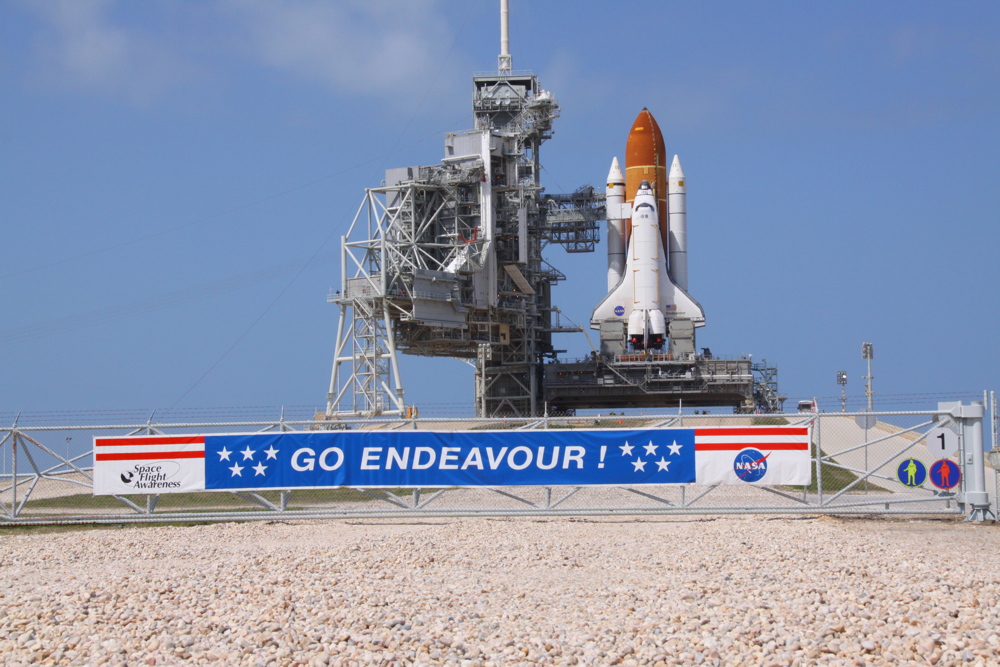Space Shuttle Endeavour Won't Launch Monday, NASA Says

This story was updated Sunday (May 1) at 9:31 a.m. EDT.
CAPE CANAVERAL, Fla. – NASA has delayed the final launch of space shuttle Endeavour once again, deciding not to try to lift off the shuttle Monday as was hoped.
A new launch date has not been set, as mission managers will need time to determine how long repairs to a broken power unit will take.
"We're looking more toward the end of the week, maybe next weekend" to launch Endeavour, NASA spokesman Allard Beutel told SPACE.com. "We won't know until tomorrow when our next launch opportunity is."
Endeavour was scheduled to lift off Friday (April 29) at 3:47 p.m. EDT (1947 GMT), but mission managers called off the attempt at 12:16 p.m. EDT (1616 GMT) when they gave up hope of fixing a failed auxiliary power unit (APU) on the shuttle. The unit supplies power to the hydraulic systems Endeavour relies on, for example its landing gear. [Photos: Shuttle Endeavour's Final Voyage]
"This was a pretty straightforward scrub," said launch director Mike Leinbach during a press conference Friday afternoon. "We don't like lifting off without redundancy especially in a critical system."
Two heaters that are supposed to keep the power unit from freezing on orbit failed, which would have rendered the APU useless once Endeavour reached space.
Breaking space news, the latest updates on rocket launches, skywatching events and more!
Engineers have yet to isolate the root cause of the problem, but inspections conducted Saturday point toward a failed avionics box, which powers the heaters that protect the critical unit.
Fixing the problem will likely take some time, partly because the broken element is in a hard-to-reach area of the shuttle's aft section.
Friday's attempted launch was to be witnessed by a crowd that had swelled up to 750,000, as well as President Barack Obama and his family. The Obamas visited the Kennedy Space Center anyway, and took a tour of the facility where the shuttle Atlantis is being prepped for its last launch on June 28.
"Even though we scrubbed, the president elected to continue with his visit to the Kennedy Space Center with his family, and I think he really enjoyed it," said Bob Cabana, director of the Kennedy Space Center. "I think it was great that he came down today."
Also hoping to view the launch was Congresswoman Gabrielle Giffords, D-Ariz., who was here to watch her husband Mark Kelly fly aboard Endeavour as its commander. Giffords was shot in the head during an assassination attempt in January, but has reportedly made great strides in recovery. She had traveled from her Houston hospital to Kennedy Space Center for the launch.
Endeavour is due to carry six astronauts on one final visit to the International Space Station. Endeavour will deliver a $2 billion astrophysics experiment to search for antimatter and dark matter, and a platform full of spare supplies for the station.
You can follow SPACE.com senior writer Clara Moskowitz on Twitter @ClaraMoskowitz. Visit SPACE.com for complete coverage of Endeavour's final mission STS-134 or follow us @Spacedotcom and on Facebook.

Clara Moskowitz is a science and space writer who joined the Space.com team in 2008 and served as Assistant Managing Editor from 2011 to 2013. Clara has a bachelor's degree in astronomy and physics from Wesleyan University, and a graduate certificate in science writing from the University of California, Santa Cruz. She covers everything from astronomy to human spaceflight and once aced a NASTAR suborbital spaceflight training program for space missions. Clara is currently Associate Editor of Scientific American. To see her latest project is, follow Clara on Twitter.
